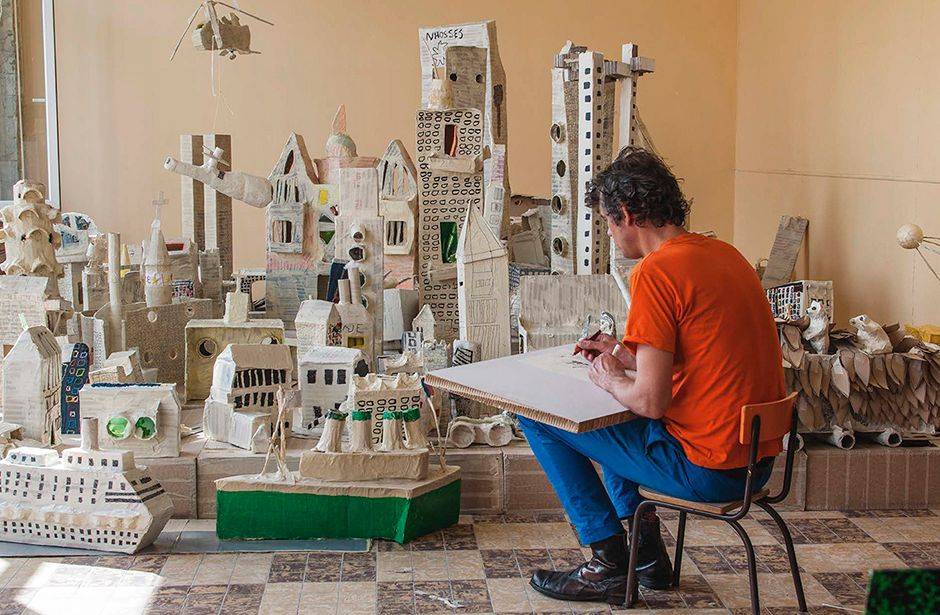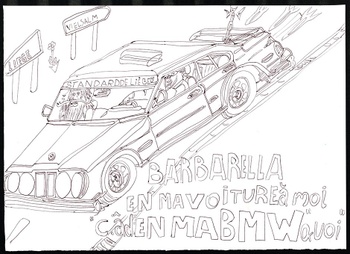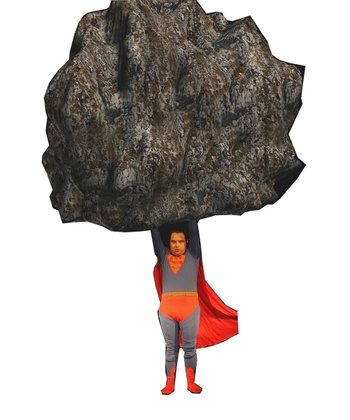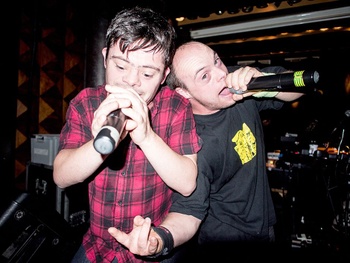BrutPop and La "S" Grand Atelier are joining forces for the second edition of the nomadic festival What Is It?, which will take place in Brussels. With artistic collaborations, curiosity, raw power, and tons of talent, it aims to change our perspective on artists with a mental disability and, ultimately, to make itself irrelevant. A serious issue, a noble cause, and a fistful of pride!

© La S Grand Atelier
What Is It? Festival works with artists with a mental disability
"We expect people with a mental disability to try and be as normal as possible, to avoid unusual or eccentric behaviour, and to keep their symptoms as hidden and repressed as they can. On the other hand, we expect artists to distinguish themselves and present themselves to the world in the most special and unique way possible. It is this paradox that we seek to question," says Antoine Capet, a social worker, educator, and along with musician David Lemoine, the key figure in BrutPop.
Through workshops, adapted instrument building, encounters, concerts, album releases, and exhibitions, this Paris-based platform forges unexpected relationships between art and disabilities, and at the same time involves the outside world in what is usually a private affair. In 2015, it brought the first edition of the traveling festival What Is It? to Marseille. For the second stop, in Brussels, on the road to a different mind-set for the world, the duo is joining forces with La "S" Grand Atelier, which was already part of the first edition.
The artistic laboratory based in Vielsalm organises workshops for artists with a mental disability and tries to build bridges through a residency programme through which external artists cooperate with in-house talent. One of their most striking realisations is a formidable, decade-long alliance with Frémok, the Brussels-based comics platform that presents an incomparable vision of comics and their experimental potential, infinite narrative possibilities, and the power of their poetic and human expression.

© La S Grand Atelier
Lord Building
What Is It? will see the next chapter of this rich history being written. At Brass, Frémok's Thierry Van Hasselt and Marcel Schmitz, an artist with Down's syndrome from La "S", will spend two weeks creating a sequel to their 2016 collaboration Living in FranDisco, an impressive and touching "road documentary", that takes Marcel back and forth between the Grand Atelier and his self-constructed, ever-expanding city made of cardboard, embroideries, and tape, and inhabited by folk such as Lord Building, a Cone of Chips, three versions of Saint Nicholas, a Motorised Bath Doll City Parade Girl, a Madonna, and MacGyver.
Thierry Van Hasselt: "The work that La 'S' does transforms its residents, their self-confidence, and the way they interact with other people. But it also changes the way we look at them. This city – and the friendship and journeys it has brought about – is an incredible gift. It has brought some lightness, and a positive kind of nonchalance to my drawings. That never would have happened without Marcel. Meeting him has unleashed a real transformative power."
It is not about what you can expect, it is about what you can imagine. About the elasticity of ideas and borders, and the transformative potential of art through shared experiences. This idea of cross-pollination, based on trust, audacity, and openness, is a leitmotif that runs all the way through What Is It?

© La S Grand Atelier
"We should keep them locked up, and if they suffered that would be all the better. But I simply didn't know why I should deprive them of the opportunity to meet people. And after a while, the critics changed their tune: 'Indeed, Dubuffet is no more, and these collaborations only seem to nourish the artists.' Now they embrace this mixity as a way of practising art brut. This stimulates us to continue the project."
Clenched Fist
Antoine Capet and David Lemoine established just such an exchange by curating the exhibition "Brut?" at Alice Gallery. It brought together Pakito Bolino, Messieurs Delmotte, Pascal Leyder, Enzo Schott, and others in an attempt to enrich the artistic landscape. David Lemoine: "Of course many characteristics of art brut or outsider art recur in these works: the spontaneity, the sincerity, the repetition, the idiosyncrasy of the work, etc., but there is also a profound consciousness of time. That is what we attempt to show in 'Brut?'. How they are influenced by pop culture, by new technologies… It all filters through in their practice."
"They inhabit the same reality we do, and react artistically to the same stimuli that we experience. Look at the guys in The Choolers Division, for example. They listen to Maître Gims and Michael Jackson, just like the rest of us. We're particularly interested in the filter they use to sieve through daily existence in consumer society. We share all the same points of reference, it is just that they interpret them slightly differently."
What Is It? also aims to shift our perspective in order to expand our horizons and possibilities. "I have always wondered why we should impose norms on people who do not have the required baggage to comply with those norms," Anne-Françoise Rouche says. "Many of our people, of which a considerable number have a light disability, think that 'being normal' is the only way to be accepted by society. Getting a driving license, finding a job, etc. Part of our work is to show them that they can create a positive identity for themselves and their work outside this so-called 'normality', precisely thanks to their particularity, their vulnerability, and their skills."
(Continue reading below the picture.)

David Lemoine: "I think our society is ready for a different attitude towards people with disabilities, without dogmas, norms, and rules. We have reached such a pivotal moment in contemporary art: there is a growing desire for artistic sincerity and spontaneity. And that is precisely what this festival provides."
Antoine Capet: "What's more, when looking back at our early days, when we made fanzines and exhibitions from stuff we found in the bin or that were tucked away in a desk in an institution somewhere, who could ever have expected that cultural centres in Brussels would be so enthusiastic and would fight to be part of this story? Mental disabilities have become hip. Representations of people with a disability are shifting and evolving in society. If we can manage to do that without the usual pathos, we will really have achieved something. It is not a coincidence that the poster shows happy disabled people who proudly raise their clenched fists."
Save the world
"Art brut has always been a way for artists to express their vulnerable attitudes to life and the world, and often also the desire to repair the world that overwhelms them," Anne-Françoise Rouche continues. "These artists don't map out their careers or follow hypes. They are in very direct relationships with their creations, and their practice is completely devoid of economic motives. All the positive things that happen are simply a source of joy."
"When you see The Choolers Division going at it on stage, while to them an audience of underground artists trying to be as punk as possible are immediately reduced to being a group of has-beens, it is both very funny and very sobering. Their natural way of being in the world deconstructs all the things we try so hard to construct."
"You know, when I first organised the workshops at La 'S', I realised very quickly that I should shelve my own artistic aspirations because I encountered people who were exploding with talent. I could only try to valorise that by focusing on what they can do, instead of traveling the same old route and focusing on all the things they are unable or are not allowed to do. The realisation that you are not only perceived as being a person with a disability, a lack, but as an artist, is genuinely overwhelming. Art is an incredible means to enable them to develop a positive identity."
"It is the only thing they can cling to to escape from the place they are forced into," Antoine Capet confirms. "It is the only opportunity they have to change our perspective and our perception of them. That is the power of art."
> What Is It?. 30/03 > 28/04, various locations, Brussels
Read more about: Events & Festivals , Expo
Fijn dat je wil reageren. Wie reageert, gaat akkoord met onze huisregels. Hoe reageren via Disqus? Een woordje uitleg.